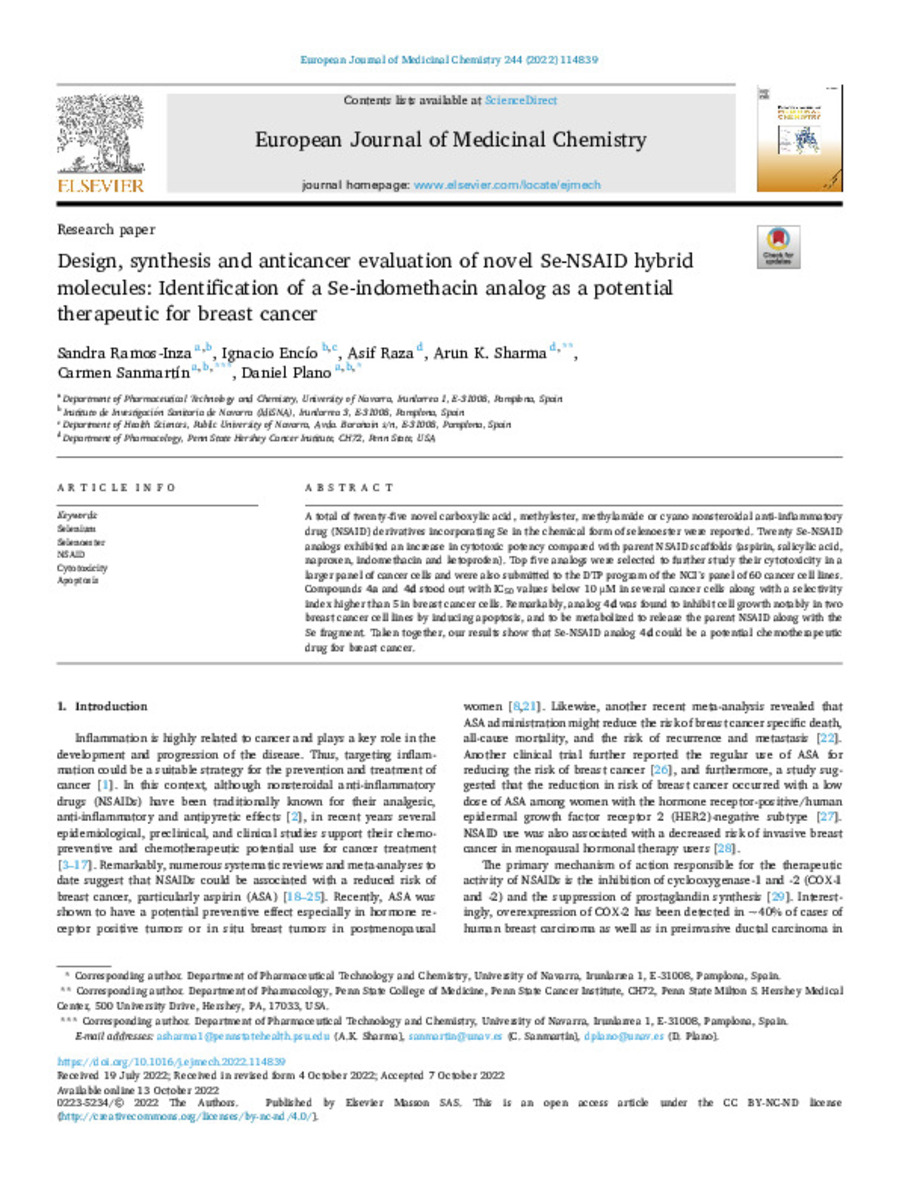Full metadata record
| DC Field | Value | Language |
|---|---|---|
| dc.creator | Ramos-Inza, S. (Sandra) | - |
| dc.creator | Encío, I. (Ignacio) | - |
| dc.creator | Raza, A. (Asif) | - |
| dc.creator | Sharma, A.K. (Arun K.) | - |
| dc.creator | Sanmartin-Grijalba, C. (Carmen) | - |
| dc.creator | Plano-Amatriain, D. (Daniel) | - |
| dc.date.accessioned | 2023-05-03T07:46:59Z | - |
| dc.date.available | 2023-05-03T07:46:59Z | - |
| dc.date.issued | 2022 | - |
| dc.identifier.citation | Ramos-Inza, S. (Sandra); Encío, I. (Ignacio); Raza, A. (Asif); et al. "Design, synthesis and anticancer evaluation of novel Se-NSAID hybrid molecules: Identification of a Se-indomethacin analog as a potential therapeutic for breast cancer". European Journal of Medicinal Chemistry. 244, 2022, 114839 | es_ES |
| dc.identifier.issn | 1768-3254 | - |
| dc.identifier.uri | https://hdl.handle.net/10171/66143 | - |
| dc.description.abstract | A total of twenty-five novel carboxylic acid, methylester, methylamide or cyano nonsteroidal anti-inflammatory drug (NSAID) derivatives incorporating Se in the chemical form of selenoester were reported. Twenty Se-NSAID analogs exhibited an increase in cytotoxic potency compared with parent NSAID scaffolds (aspirin, salicylic acid, naproxen, indomethacin and ketoprofen). Top five analogs were selected to further study their cytotoxicity in a larger panel of cancer cells and were also submitted to the DTP program of the NCI’s panel of 60 cancer cell lines. Compounds 4a and 4d stood out with IC50 values below 10 μM in several cancer cells along with a selectivity index higher than 5 in breast cancer cells. Remarkably, analog 4d was found to inhibit cell growth notably in two breast cancer cell lines by inducing apoptosis, and to be metabolized to release the parent NSAID along with the Se fragment. Taken together, our results show that Se-NSAID analog 4d could be a potential chemotherapeutic drug for breast cancer. | es_ES |
| dc.description.sponsorship | This work was financially supported by the Plan de Investigación de la Universidad de Navarra, PIUNA (2018-19), and the Department of Pharmacology and Penn State Cancer Institute of the Penn State College of Medicine. Sandra Ramos-Inza also acknowledges the FPU program from the Spanish Ministry of Universities for a Ph.D. fellowship (FPU18/ 04679) and a mobility grant (EST19/00898). The authors wish to ex- press their gratitude to Dr. Esther Moreno for providing the enzymes for the study of the stability in gastrointestinal fluids, and to Dr. Elena González-Peñas and Dr. Elena Lizarraga for their assistance with the HPLC measurements. S. Ramos-Inza et al. | es_ES |
| dc.language.iso | eng | es_ES |
| dc.publisher | Elsevier | es_ES |
| dc.rights | info:eu-repo/semantics/openAccess | es_ES |
| dc.subject | Selenium | es_ES |
| dc.subject | Selenoester | es_ES |
| dc.subject | NSAID | es_ES |
| dc.subject | Cytotoxicity | es_ES |
| dc.subject | Apoptosis | es_ES |
| dc.title | Design, synthesis and anticancer evaluation of novel Se-NSAID hybrid molecules: Identification of a Se-indomethacin analog as a potential therapeutic for breast cancer | es_ES |
| dc.type | info:eu-repo/semantics/article | es_ES |
| dc.description.note | This is an open access article under the CC BY-NC-ND license | es_ES |
| dc.identifier.doi | 10.1016/j.ejmech.2022.114839 | - |
| dadun.citation.publicationName | European Journal of Medicinal Chemistry | es_ES |
| dadun.citation.startingPage | 114839 | es_ES |
| dadun.citation.volume | 244 | es_ES |
| dc.identifier.pmid | 36257283 | - |
Files in This Item:
Statistics and impact
Items in Dadun are protected by copyright, with all rights reserved, unless otherwise indicated.






